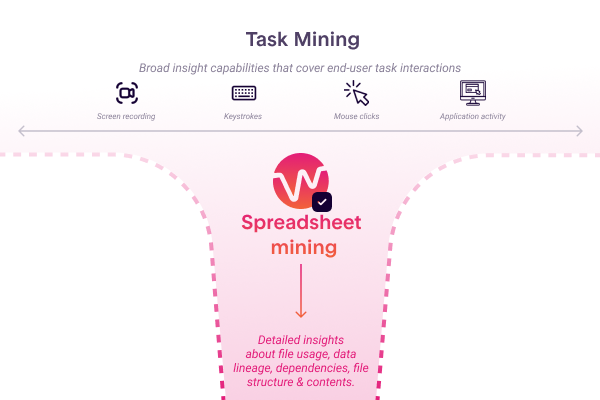%201.svg)
This post explores the differences between process mining and task mining and how Workscope's spreadsheet mining solution can enhance the process optimisation journey.
Process Mining vs Task Mining: Understanding the differences & where Workscope fits in

Businesses today are constantly seeking new ways to optimise their operations, improve internal processes and identify areas for process automation.
With the growing number of applications used in modern organisations, understanding how tools are used has become a critical tool for companies to gain insights into the performance of their operations and make informed decisions about process improvement.
Two important areas of data analysis in the sphere of operational efficiency are process mining and task mining. While both techniques aim to gather information about business processes and identify areas to optimise operations, their approach, scope, and results differ. In this post, we will explore the differences between process mining and task mining.
If you are already familiar with these concepts and want to understand how Workscope's spreadsheet mining solution can enhance your optimisation journey, then you can jump down the article by clicking here to see where we cover that.
Why data-driven process discovery & process automation is the way forward
Traditionally, companies have focused on growth-related value drivers to create new revenue streams and accelerate existing ones. However, the macroeconomic environment has shifted, and companies need to do more with less.
As CFOs scrutinise and consolidate internal spending, there is an increased focus on measuring productivity and efficiency value drivers that can create cost reduction, more efficiency and outcomes that positively affect customers.
For regulated industries such as finance, regulators are increasingly taking action against firms that do not have adequate internal controls. Therefore, many companies have no choice but to understand how their internal processes work to ensure they can maintain or increase compliance and operate with fewer errors.
As core business processes constantly evolve and continue as a going concern, for many organisations, there is an opportunity to optimise processes. By leveraging technology to assess the current state of business operations automatically, companies can save valuable time in identifying optimisation or process automation opportunities without creating friction or disruption, which could negatively impact end-users.
Therefore, a technology-led approach to process analysis allows companies to collect and monitor the key performance indicators which impact their operational performance. This can be hugely beneficial in helping companies manage the volume of information, implement change faster and reduce costs whilst avoiding significant manual effort.

Six benefits of leveraging automation and data mining?
Better allocation of resources
Gathering process insights manually takes time, is costly and prone to errors. Automation enables you to rapidly get transparency across every end-to-end process and make more informed decisions about the worthiness of further investment in transformation and change management initiatives.
Data-driven decision making
Accurate, unbiased insights into processes help you identify process performance problems, understand how much variation there is in processes across the organisation and deliver data that enable a comprehensive understanding on which to base decisions.
Improved Process Efficiencies
Identify areas of inefficiency in business processes and pinpoint the places where you can remove bottlenecks.
Continuous Improvement
A state of continuous improvement can be achieved through the ongoing application of process discovery, ensuring companies can continue to identify opportunities for business process automation and long-term process optimisation.
Increased Competitive Advantage:
Companies that focus on process optimisation and examine how they can achieve efficient business outcomes will ultimately operate more effectively and stay ahead of the competition.

What is process mining?
Process mining is a data-driven approach to discovering, analysing, and improving real-world processes run through systems. Process mining use cases typically focus on monitoring processes that touch systems such as ERP or CRM platforms.
It provides a comprehensive view of business processes and provides organisations with a clear understanding of how their processes are being executed.
Each time a process moves through a system, it leaves a digital footprint or breadcrumb called a system log or event log data. By gathering these logs, process mining platforms can depict the steps involved in a particular process and present end-to-end visibility into each step or path.
Benefits of process mining
By analysing this data, you can start to answer questions about workflows such as:
- Where can we remove bottlenecks?
- Where are resources overloaded?
- Where are manual inputs required?
- Where are the opportunities to automate or streamline?
- Why should we prioritise certain processes over others?
- How do actions impact key performance indicators?
Transparency helps business process management stakeholders make informed decisions about process improvement or compare and benchmark the performance of different departmental processes without having to gather information manually.

What companies provide process mining solutions?
- ARIS Process Mining
- Celonis
- Fluxicon
- IBM Process Mining
- Minit
- PAFnow
- QPR Software
- Signavio
- Software AG
- UiPath
What is task mining?
Unlike process mining, which looks at the workflow as a whole, task mining concentrates on individual tasks and how they contribute to the overall process.
Tasks comprise several steps, usually performed manually by employees on their computers and considered smaller components of a process or subprocess.

Instead of looking at system logs, task mining captures user interaction data such as:
- Clicks
- Keystrokes
- Copy/paste actions
- Application open events
- Time spent using an applications
The benefits of task mining
With a detailed understanding of the tasks performed by individuals within a process, task mining enables you to:
- Get a better understanding of activities taking place outside of core systems
- Gather workflow insights automatically without disturbing end-user workflow
- Pinpoint the time-consuming tasks and low-value activities
- Discover where resources should be deployed for implementing process automation
- Identify training needs for end-users or the functionality gaps of internal systems
The resulting data can be used to understand the end-user behaviour and the effectiveness of individual tasks as they are being executed to achieve business outcomes. This helps managers identify where improvement or automation opportunities exist, which could save time for more important activities and enable end-users to perform better.
What companies provide task mining solutions?
The key differences between Process Mining and Task Mining
The key difference between process mining and task mining lies in their scope and level of detail. Process mining provides a broader overview of a business process and identifies opportunities for improvement, while task mining provides a more detailed understanding of the tasks performed by individuals within a process.
The type of data used in process mining and task mining also differs. Process mining relies on event logs or system logs to analyse business processes, while task mining focuses on data related to individual tasks, such as keystrokes and interactions with applications.
Another difference between the two techniques is their purpose. Process mining is typically used to identify inefficiencies and bottlenecks within a process, while task mining is used to understand individual behaviour and identify opportunities for improvement.
For example, process mining can help identify why a process takes too long to complete, whereas task mining can be used to understand how frequently an individual performs a task.

Where Workcsope adds value
When companies embark on a data mining initiative, the end goal is to maximise process optimisation. The route to achieving this can differ across the organisation. For example, this could involve:
- optimising the sequence of steps
- re-engineering the process
- migrating a process into another platform (e.g. low/no-code)
- eliminating manual steps via robotic process automation
To achieve a successful outcome, you need transparency over the entire business, including spreadsheet processes. This requires knowledge about what processes exist and understanding what happens when spreadsheets are involved. This means understanding how each spreadsheet works, its data dependencies, and its broader business impact.
Task mining insights give a broad view and capture information about how end-user interact with applications. However, the insights about the files or the data within them are typically limited to what can be gathered from OCR or NLP.

Spreadsheet files are much more complex and can contain a range of formulas, objects and data dependencies. This information is not readily captured by task mining, and because there is no standard way to build a spreadsheet, there is no simple way to collect this information.
Workscope solves this by analysing how people interact with spreadsheets and everything about each file, such as how complex it is, what data lineage it contains, or what errors exist within the file. This provides an additional dimension to process discovery and allows organisations to understand more about the process dependencies across the organisation.
Spreadsheets are often the most widely used end-user-developed application in an organisation. Adding Workscope's fully automated platform to your suite of mining tools will provide an additional layer of detail.
Workscope's data insights will further enhance your ability to rationalise the current state of operations. This enables you to define business needs better, focus resources on the most critical processes and identify opportunities to deliver the greatest return on investment.
The benefits of Workscope's spreadsheet mining:
Shorter time to value & improved productivity
Spreadsheet process discovery is rapid, and the analysis is fully automated. Data gathering does not rely on costly surveys or interviews that could result in ambiguous data insights. Furthermore, end-users are not disturbed in any way. Therefore, you can start taking action quickly and with minimal disruption.
Improved process insights
Leverage more detailed end-to-end insights and gain a better understanding of how employees are building and using spreadsheets, connecting to data, or interacting with repetitive tasks, which are potential candidates for process automation.
Better Risk Management
Automatic process discovery will identify tasks that depend on spreadsheets and highlight risks that touch critical areas of the organisation. This enables you to operate with less errors by automatically notifying end-users before issues materialise and impact business outcomes.
Establishing a process inventory makes it easier to remediate risks quicker and demonstrate good risk management.
Better allocation of resources
The resulting process insights deliver an enhanced view of the "current state", meaning you can use data to prioritise how to allocate resources for process optimisation or process automation opportunities.
Conclusion
Without leveraging technology, organisations can't see and understand what’s happening in spreadsheet processes on a day-to-day basis, making it impossible to accurately assess the "current state" or know whether tasks are performing “as expected.”
Spreadsheet process discovery provides a valuable enhancement for companies that want to understand spreadsheet process workflows.
Workscope delivers an additional layer of detail over the current state of existing business processes, which makes it easier to implement process optimisation as part of a digital transformation or change management programme.
This, therefore, enhances the speed and efficiency at which you can assess internal processes and identify the value drivers that lead to lower costs and increased efficiency.
Ultimately, if you can’t see it, you can't fix it.
If you want to improve your operations and drive maximum efficiency, consider implementing spreadsheet process discovery alongside your existing process or task-mining initiative.
For more information, please get in touch via info@workscope.com
Stay up to date and read the latest news from Workscope
Related Posts

Regulatory Reporting And Controls: Thematic Findings From The PRA
PRA highlights significant deficiencies in regulatory reporting processes, urging firms to improve governance, controls, and investment in infrastructure.

6 Key Takeaways from GFMI Model Risk Management 2021 Conference
Model Risk Management (MRM) is a top priority for 2021. We have compiled the top six themes from discussions with senior industry leaders.

Workscope to join ING Lab Brussels 2020
Workscope has been selected to participate in ING Labs Brussels initiative as part of a proof of concept with ING, alongside six other technology start-ups.

.svg)
